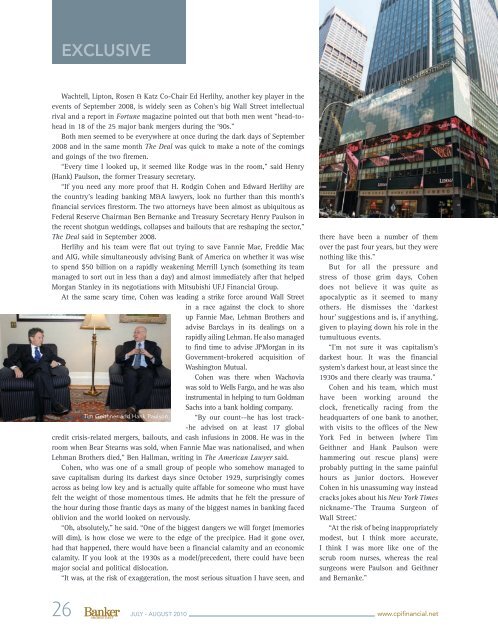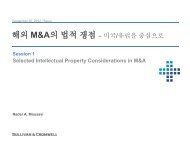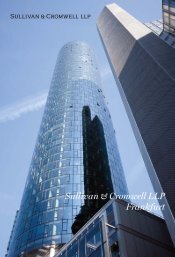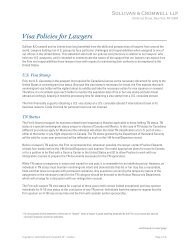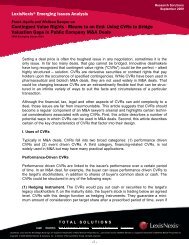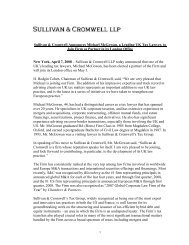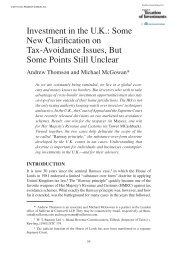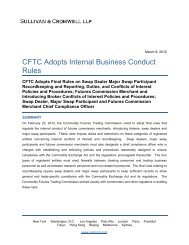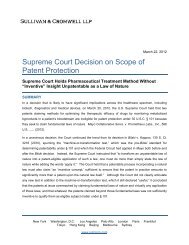here - Sullivan & Cromwell
here - Sullivan & Cromwell
here - Sullivan & Cromwell
You also want an ePaper? Increase the reach of your titles
YUMPU automatically turns print PDFs into web optimized ePapers that Google loves.
EXCLUSIVE<br />
Wachtell, Lipton, Rosen & Katz Co-Chair Ed Herlihy, another key player in the<br />
events of September 2008, is widely seen as Cohen’s big Wall Street intellectual<br />
rival and a report in Fortune magazine pointed out that both men went “head-tohead<br />
in 18 of the 25 major bank mergers during the ‘90s.”<br />
Both men seemed to be everyw<strong>here</strong> at once during the dark days of September<br />
2008 and in the same month The Deal was quick to make a note of the comings<br />
and goings of the two firemen.<br />
“Every time I looked up, it seemed like Rodge was in the room,” said Henry<br />
(Hank) Paulson, the former Treasury secretary.<br />
“If you need any more proof that H. Rodgin Cohen and Edward Herlihy are<br />
the country’s leading banking M&A lawyers, look no further than this month’s<br />
financial services firestorm. The two attorneys have been almost as ubiquitous as<br />
Federal Reserve Chairman Ben Bernanke and Treasury Secretary Henry Paulson in<br />
the recent shotgun weddings, collapses and bailouts that are reshaping the sector,”<br />
The Deal said in September 2008.<br />
Herlihy and his team were flat out trying to save Fannie Mae, Freddie Mac<br />
and AIG, while simultaneously advising Bank of America on whether it was wise<br />
to spend $50 billion on a rapidly weakening Merrill Lynch (something its team<br />
managed to sort out in less than a day) and almost immediately after that helped<br />
Morgan Stanley in its negotiations with Mitsubishi UFJ Financial Group.<br />
At the same scary time, Cohen was leading a strike force around Wall Street<br />
in a race against the clock to shore<br />
up Fannie Mae, Lehman Brothers and<br />
advise Barclays in its dealings on a<br />
rapidly ailing Lehman. He also managed<br />
to find time to advise JPMorgan in its<br />
Government-brokered acquisition of<br />
Washington Mutual.<br />
Cohen was t<strong>here</strong> when Wachovia<br />
was sold to Wells Fargo, and he was also<br />
instrumental in helping to turn Goldman<br />
Sachs into a bank holding company.<br />
Tim Geithner and Hank Paulson “By our count--he has lost track-<br />
-he advised on at least 17 global<br />
credit crisis-related mergers, bailouts, and cash infusions in 2008. He was in the<br />
room when Bear Stearns was sold, when Fannie Mae was nationalised, and when<br />
Lehman Brothers died,” Ben Hallman, writing in The American Lawyer said.<br />
Cohen, who was one of a small group of people who somehow managed to<br />
save capitalism during its darkest days since October 1929, surprisingly comes<br />
across as being low key and is actually quite affable for someone who must have<br />
felt the weight of those momentous times. He admits that he felt the pressure of<br />
the hour during those frantic days as many of the biggest names in banking faced<br />
oblivion and the world looked on nervously.<br />
“Oh, absolutely,” he said. “One of the biggest dangers we will forget (memories<br />
will dim), is how close we were to the edge of the precipice. Had it gone over,<br />
had that happened, t<strong>here</strong> would have been a financial calamity and an economic<br />
calamity. If you look at the 1930s as a model/precedent, t<strong>here</strong> could have been<br />
major social and political dislocation.<br />
“It was, at the risk of exaggeration, the most serious situation I have seen, and<br />
t<strong>here</strong> have been a number of them<br />
over the past four years, but they were<br />
nothing like this.”<br />
But for all the pressure and<br />
stress of those grim days, Cohen<br />
does not believe it was quite as<br />
apocalyptic as it seemed to many<br />
others. He dismisses the ‘darkest<br />
hour’ suggestions and is, if anything,<br />
given to playing down his role in the<br />
tumultuous events.<br />
“I’m not sure it was capitalism’s<br />
darkest hour. It was the financial<br />
system’s darkest hour, at least since the<br />
1930s and t<strong>here</strong> clearly was trauma.”<br />
Cohen and his team, which must<br />
have been working around the<br />
clock, frenetically racing from the<br />
headquarters of one bank to another,<br />
with visits to the offices of the New<br />
York Fed in between (w<strong>here</strong> Tim<br />
Geithner and Hank Paulson were<br />
hammering out rescue plans) were<br />
probably putting in the same painful<br />
hours as junior doctors. However<br />
Cohen in his unassuming way instead<br />
cracks jokes about his New York Times<br />
nickname-‘The Trauma Surgeon of<br />
Wall Street.’<br />
“At the risk of being inappropriately<br />
modest, but I think more accurate,<br />
I think I was more like one of the<br />
scrub room nurses, w<strong>here</strong>as the real<br />
surgeons were Paulson and Geithner<br />
and Bernanke.”<br />
26<br />
JULY - AUGUST 2010<br />
www.cpifinancial.net


